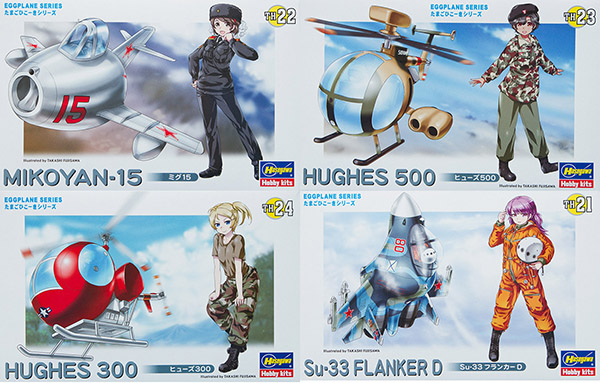
Hasegawa Egg Planes: MiG-15, Hughes 300, Hughes 500, and Su-33
By Chris Banyai-Riepl
Overview
Hasegawa continues to expand their egg plane series, both with re-releases of their classic first edition from the 1980s and new releases. These latest releases follow that trend, mixing a handful of re-releases with one new release. Like other re-releases, the older ones do not include the colorful figures and stand. The original release of the MiG-15 had Chinese cartoon characters and a Great Wall of China base, for example. These early releases also tend to be very simple in construction. The new releases are more complex, better detailed, and include a figure. Here's an overview of the most recent releases.
The Mikoyan-15
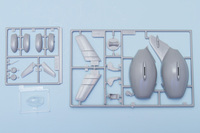 The MiG-15 kit is probably the simplest out of this latest quartet of egg planes. One of the earliest releases by Hasegawa, this kit is molded in light gray plastic with minimal surface detailing. In fact the only lines on the fuselage are recessed lines for the rudder and air brakes and raised lines around the intake and on the leading edge of the fin.
The MiG-15 kit is probably the simplest out of this latest quartet of egg planes. One of the earliest releases by Hasegawa, this kit is molded in light gray plastic with minimal surface detailing. In fact the only lines on the fuselage are recessed lines for the rudder and air brakes and raised lines around the intake and on the leading edge of the fin.
For construction, this can easily be a model built in an afternoon. There is a rudimentary cockpit that includes a one-piece tub and seat and a decal instrument panel that fits onto the panel that is molded in the fuselage halves. There is an insert for the intake, and that's it for the fuselage assembly. The instructions don't mention the need of any weight, but I'm guessing this will need some to keep it sitting on its nose wheel. Luckily, this is an egg plane, so there's LOTS of room for weight here.
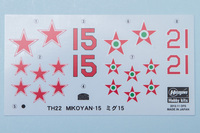 With the fuselage together, the only thing left is the external details. You get solid tailplanes and wings, both with solid tabs for attaching. The nose gear is molded with the fuselage, while the main gear comes with the strut and door molded together and a separate mainwheel. There are fuel tanks for the wings, an antenna for the fuselage, and the canopy, and that's it for this one. Decals are simple as well, with two options, both in overall silver: Red 15 of the Soviet Union and Red 21 of the Hungarian Air Force.
With the fuselage together, the only thing left is the external details. You get solid tailplanes and wings, both with solid tabs for attaching. The nose gear is molded with the fuselage, while the main gear comes with the strut and door molded together and a separate mainwheel. There are fuel tanks for the wings, an antenna for the fuselage, and the canopy, and that's it for this one. Decals are simple as well, with two options, both in overall silver: Red 15 of the Soviet Union and Red 21 of the Hungarian Air Force.
The Hughes 300
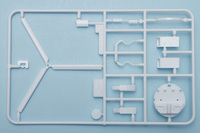 A later release, the Hasegawa egg helicopters definitely translate well into the egg shape. This one is the Hughes 300, a very popular light training and general aviation helicopter. Molded in white plastic, the kit features quite a bit of detail, which is understandable given the big cockpit glazing and open structure of the helicopter. The decal sheet provides a single option for a training helicopter, which features large areas of red, so the white plastic is a great benefit to painting this one.
A later release, the Hasegawa egg helicopters definitely translate well into the egg shape. This one is the Hughes 300, a very popular light training and general aviation helicopter. Molded in white plastic, the kit features quite a bit of detail, which is understandable given the big cockpit glazing and open structure of the helicopter. The decal sheet provides a single option for a training helicopter, which features large areas of red, so the white plastic is a great benefit to painting this one.
 So, given the big open clear parts, construction therefore begins with the cockpit. Here we have a floor piece that has separate seats, separate control columns, and a two-piece instrument panel that gets decal instruments. This fits into the big clear egg that makes up the cabin area. There is a separate piece that fits over the top, and all that's left here is to mask off the large expanses of clear sections prior to painting (and this kit probably would benefit from painting in assemblies).
So, given the big open clear parts, construction therefore begins with the cockpit. Here we have a floor piece that has separate seats, separate control columns, and a two-piece instrument panel that gets decal instruments. This fits into the big clear egg that makes up the cabin area. There is a separate piece that fits over the top, and all that's left here is to mask off the large expanses of clear sections prior to painting (and this kit probably would benefit from painting in assemblies).
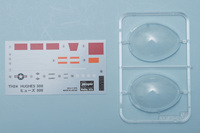 For the main helicopter body, this is built up from a two-piece engine/tail boom assembly that fits onto the one-piece landing skid base. Two support struts are then attached to the boom. The tail rotor and horizontal fin are separate, as is the main rotor (which also has a separate top cap). The two fuel tanks are separate and split into right and left halves. Having these separate will make painting easier. For painting, the markings are for a US Army training helicopter, so there's lots of white and red here. Painting the cabin and fuel tanks separately will simplify this part greatly, as those are red while the rest is mostly white.
For the main helicopter body, this is built up from a two-piece engine/tail boom assembly that fits onto the one-piece landing skid base. Two support struts are then attached to the boom. The tail rotor and horizontal fin are separate, as is the main rotor (which also has a separate top cap). The two fuel tanks are separate and split into right and left halves. Having these separate will make painting easier. For painting, the markings are for a US Army training helicopter, so there's lots of white and red here. Painting the cabin and fuel tanks separately will simplify this part greatly, as those are red while the rest is mostly white.
The Hughes 500
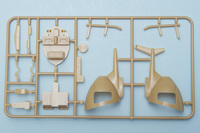 The second egg helicopter from Hasegawa is the Hughes 500D Defender. This is one where they could have provided an actual scale model and it would still look like an egg, so this is an easy transition to true egginess here. This one is molded in tan plastic and like the previous Hughes 300, it features quite a bit of detailing. As it is the Defender variant of the Hughes 500, it features military attachments and a single decal option for an African 500D Defender.
The second egg helicopter from Hasegawa is the Hughes 500D Defender. This is one where they could have provided an actual scale model and it would still look like an egg, so this is an easy transition to true egginess here. This one is molded in tan plastic and like the previous Hughes 300, it features quite a bit of detailing. As it is the Defender variant of the Hughes 500, it features military attachments and a single decal option for an African 500D Defender.
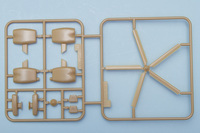 The interior is made up in a similar fashion to the Hughes 300, with a floor piece getting separate seats, control columns, and a two-piece instrument panel with decal instruments. In this case, the rear seats are molded into the floor piece. The finished cockpit then gets sandwiched between the two fuselage halves, which also include the rear boom. There is an insert for the turbine exhaust, and the landing skis are separate.
The interior is made up in a similar fashion to the Hughes 300, with a floor piece getting separate seats, control columns, and a two-piece instrument panel with decal instruments. In this case, the rear seats are molded into the floor piece. The finished cockpit then gets sandwiched between the two fuselage halves, which also include the rear boom. There is an insert for the turbine exhaust, and the landing skis are separate.
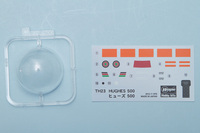 With the fuselage together, the rest of the assembly goes fast. The side TOW missile pods are split into upper and lower halves, while the sensor on the top of the rotor is split into right and left halves. The tail rotor and top fin are separate as well. A large clear front piece finishes up the assembly, and once those panels are masked off, you can paint it up in the two-tone brown camouflage scheme of the Kenyan Army option provided in the decals.
With the fuselage together, the rest of the assembly goes fast. The side TOW missile pods are split into upper and lower halves, while the sensor on the top of the rotor is split into right and left halves. The tail rotor and top fin are separate as well. A large clear front piece finishes up the assembly, and once those panels are masked off, you can paint it up in the two-tone brown camouflage scheme of the Kenyan Army option provided in the decals.
The Su-33 Flanker D
This is a new-release egg plane, and as such it is a much more complex kit. This kit is molded in blue-gray and black plastic (plus the clear canopy) and features very nice surface detailing throughout. There are two pilot figure options provided, and the decals provide several colorful Flanker options.
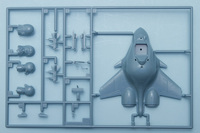 Starting with the interior, while this kit features more detail than the other three re-releases mentioned here, it interestingly is the only one without a separate cockpit. What you get is molded into the upper fuselage, but since it is designed to take the pilot figure, this is understandable. You still get a decal instrument panel, though, and once the pilot figure is in place that will be good enough. Speaking of pilot figures, the two options are helmeted or unhelmeted, with the bare head one getting two choices of decal eyes.
Starting with the interior, while this kit features more detail than the other three re-releases mentioned here, it interestingly is the only one without a separate cockpit. What you get is molded into the upper fuselage, but since it is designed to take the pilot figure, this is understandable. You still get a decal instrument panel, though, and once the pilot figure is in place that will be good enough. Speaking of pilot figures, the two options are helmeted or unhelmeted, with the bare head one getting two choices of decal eyes.
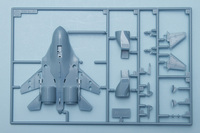 With the cockpit sorted out, the assembly can take shape. The main aircraft assembly is split into upper and lower halves, with a bulkhead and support pin provided to keep things positioned correctly. The intakes are separate, as are the vertical fins and exhausts. For armament, this kit provides the wingtip missiles and a pair of missiles for under the wing. The landing gear is well done, with separate struts, wheels, and wheel doors.
With the cockpit sorted out, the assembly can take shape. The main aircraft assembly is split into upper and lower halves, with a bulkhead and support pin provided to keep things positioned correctly. The intakes are separate, as are the vertical fins and exhausts. For armament, this kit provides the wingtip missiles and a pair of missiles for under the wing. The landing gear is well done, with separate struts, wheels, and wheel doors.
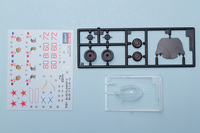 Painting and decaling is a bit complex in this kit. The Su-33 features a three-color camouflage for starters, and once that's painted on you get lots of standard markings and stenciling to apply. The tail markings are the primary difference in the options, with one having a tiger's head and one having an eagle, and the kit provides two sets of numbers for each option.
Painting and decaling is a bit complex in this kit. The Su-33 features a three-color camouflage for starters, and once that's painted on you get lots of standard markings and stenciling to apply. The tail markings are the primary difference in the options, with one having a tiger's head and one having an eagle, and the kit provides two sets of numbers for each option.
Conclusion
These are great little diversions from the more traditional models out there and can be a fun weekend project. While the kit decals are great, there is some temptation to go beyond those, especially with the helicopters, as there are lots of interesting civilian versions of both of those. My thanks to Hasegawa USA for the review samples.
